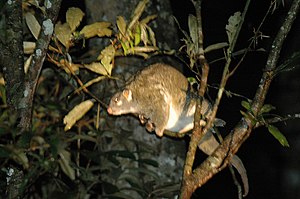Stripe ringtail pouches
| Stripe ringtail pouches | ||||||||||||
|---|---|---|---|---|---|---|---|---|---|---|---|---|

Striped ringtail butler ( Pseudochirops archeri ) |
||||||||||||
| Systematics | ||||||||||||
|
||||||||||||
| Scientific name | ||||||||||||
| Pseudochirops archeri | ||||||||||||
| ( Collett , 1884) |
| 3 | · | 1 | · | 3 | · | 4th | = 40 |
| 2 | · | 0 | · | 3 | · | 4th |

The striped ring-tailed pouch ( Pseudochirops archeri ) is a marsupial in the family of the ring -tailed pouch found in northeast Australia .
features
The species reaches a head-torso length of 28.5 to 37.7 cm and a weight of 670 to 1,350 g. It has a plump body and a prehensile tail . The latter is unusually short and thickened near the trunk. The unused tip of the tail curls up. The dense and soft fur of the striped ringtail butler is made up of hair that is banded black, yellow, and white, resulting in a lime green color. The name-giving feature is the two silver stripes on the back. White spots under the eyes and ears are also noticeable. Like other ring pouches, the species has an opposable "thumb" on its front feet and an opposable big toe on its hind feet.
The molar teeth have crescent-shaped edges. That is why the striped ring-tailed bagler does not grind its leaf food, but rather cuts it up.
distribution
This marsupial inhabits the eastern areas of the Cape York Peninsula in the state of Queensland in Australia. It can be found in mountainous countries that are at least 300 meters above sea level. Cool rainforests serve as habitat .
Way of life
The striped ring-tailed pouch stays mainly in trees and occasionally visits the bottom. It is nocturnal and during the day rests hidden in the dense foliage on a fork of branches. He curls up into a ball with his face, front limbs and tail pressed against his stomach.
The species feeds mainly on mature leaves, which are mostly found on the edges of forests. According to a 2006 study, more than 50 percent of the diet consists of leaves of the plants Ficus fraseri , Ficus copiosa , Aleurites rockinghamensis and Arytera divaricata . The striped ringtail butler can also digest leaves of the stinging nettle family Dendrocnide . Occasionally the diet is supplemented with fruits of figs . The species is coprophagous for better utilization of the nutrients .
In the case of the striped ringtail butler, reproduction takes place in the Australian autumn and winter, especially in June and July. As with all marsupials, newborn individuals are underdeveloped. They crawl to their mother's pouch and suckle a teat. Older young animals ride on the mother's back when she goes looking for food. If they can climb independently, they will accompany their mother for a few more weeks.
Typical enemies of the species are the red owl ( Ninox rufa ), the diamond python ( Morelia spilota ) and the giant bag marten ( Dasyurus maculatus ).
Taxonomy
A phylogenetic study from 2010 came to the conclusion that the genus of the green ring -tailed bagger is paraphyletic with respect to the striped ring-tailed bagger . It had separated from a common ancestor of the other members of the genus before the rock ringbutler ( Petropseudes dahli ) split off.
status
The range of the species is less than 5,000 km², but it mainly consists of protected regions that are designated as world natural heritage . The total stock is considered stable. The IUCN lists the striped ringtail bagger as Least Concern .
supporting documents
- ↑ Don E. Wilson , DeeAnn M. Reeder (Ed.): Mammal Species of the World . A taxonomic and geographic Reference . 3. Edition. 2 volumes. Johns Hopkins University Press, Baltimore MD 2005, ISBN 0-8018-8221-4 (English, Pseudochirops archeri ).
- ↑ a b c d e f Sarah Davis: Green ringtail possum in the Animal Diversity Web of the University of Michigan Museum of Zoology. 2002. Accessed November 11, 2017.
- ↑ a b c Pseudochirops archeri in the endangered Red List species the IUCN 2016 Posted by: Burnett, S. & Winter, J., 2008. Accessed November 11, 2017th
- ↑ Meredith et al. A Phylogeny and Timescale for the Evolution of Pseudocheiridae (PDF) 2010, accessed November 11, 2017.
Web links
- Specimen ingested , Australian Animal TV
